How can I create a custom page border?
Users often ask whether it is possible to add to the Art
choices on the Page Borders tab of the Borders and Shading dialog. Unlike
Publisher, Word does not offer a way to create custom Border Art, but that
doesn’t mean you can’t add a custom border to your page. Here are two ways to
approach the task, depending on the clip art you have available.
Note: This article was written for Word 2003 and
earlier. Changes in Word 2007 and above (Ribbon versions) make the procedure and tools somewhat
different. Rather than attempt to provide instructions for Word 2007 and
above along
with the existing ones for earlier versions, I have added some hints at the
end to make it easier to accomplish the same task in Word 2007 and above.
If you select Insert | Picture | Clip Art… and type
“border” into the search box, you will see an assortment of pictures that can be
used as borders or to create borders. Some, such as this one, are complete
borders:
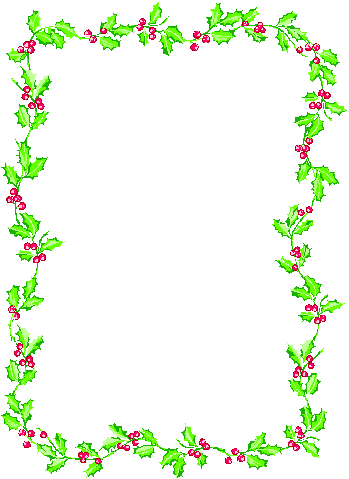
Some are corner pieces that can be rotated and combined into
a complete border:
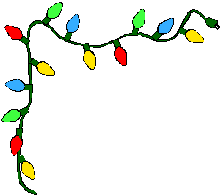
Some are straight-line pieces that would have to be repeated
and pasted together to make a border:
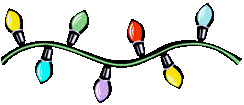
Using any of these requires a certain amount of knowledge of
how to deal with clip art, but the main part of the secret to making a page
border is to understand that the art must be anchored to the header
in order to
be behind the text and repeat on every page. That requires the following steps:
-
View | Header and Footer. This opens the header pane.
-
Insert | Picture | Clip Art… and select the desired picture. Let’s
say it’s the holly garland shown above. The result will be something like
this:

As you can see, the border has been inserted in the header, but it is making the
header huge. This is because the picture has been inserted In Line With Text.
It’s acting like a giant font character. We need to make the picture “float”
behind the text; that is, it needs to be “wrapped” or in the drawing layer.
-
Click on the picture to display the Picture toolbar:

- Click on the Text Wrapping button to show the wrapping
menu and choose Behind Text:
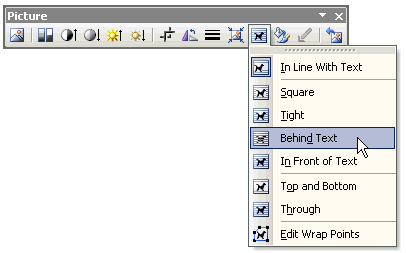
- The border is now floating on the page, and the header area is back to normal:

-
Now you need to make the
border the right size. As a start, drag it to surround the page margins.
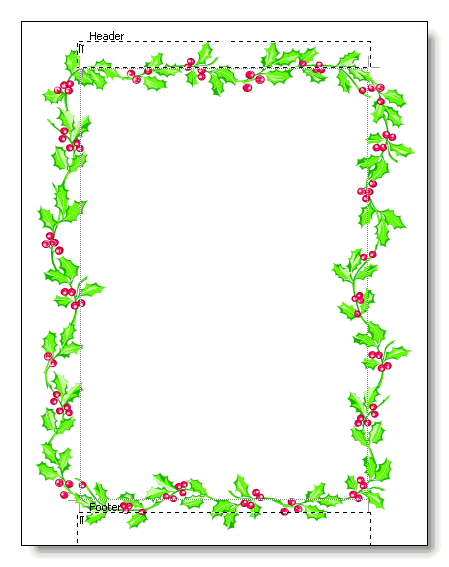
You can fine-tune the size and position using the Format
Picture dialog. In the above illustration, the clip art has been centered
using the Advanced Layout options (Format | Picture | Layout: Advanced…):
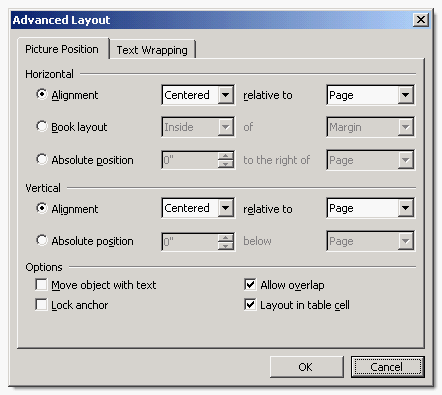
Sometimes you can’t find a made-up border that is just what
you want and would prefer to repeat a small picture around the edge of the page
(which is just what the custom Border Art feature in Publisher does). This
requires a little more work but can also be done.
-
First find the picture you want to use. For our purposes
let’s say you want to make a border of steaming cups of coffee. So you find
an appropriate piece of clip art by searching for “coffee.”

-
To assist you in placing the clip art, insert a temporary
page border. Use the default solid line and box border. Click Options…
and change the “From edge of page” setting to 31 points.
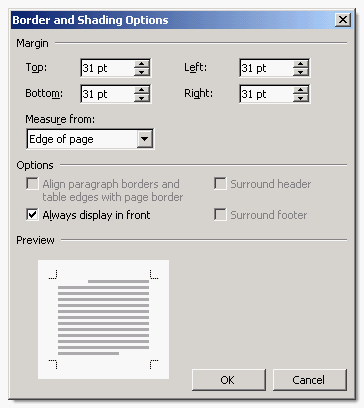
-
This will give you a
border like this:
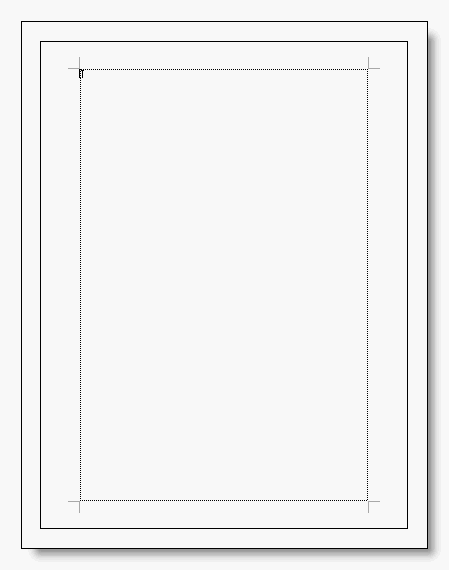
-
View | Header and
Footer to open the header pane. Insert your chosen clip art picture.
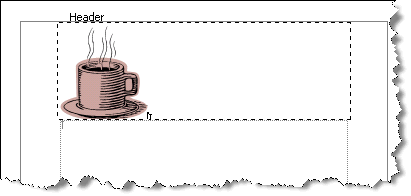
-
As before, you will need to change the wrapping of the
picture from In Line With Text to Behind Text.
-
Clearly this picture will be too big for a border at its
full size, so you will need to make it smaller. Double-click on the picture
to open the Format Picture dialog and select the Size tab. Making sure that
the “Lock aspect ratio” box is checked, change the size to a more
appropriate one. In this case, 25% has been selected.
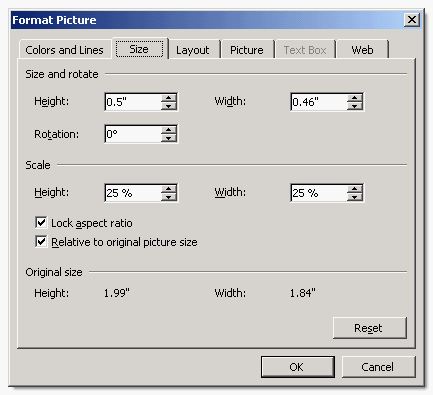
-
Select the picture and press Ctrl+D to duplicate
it several times. Drag one of the copies so that it is in the top left
corner of the page border outline. Drag another to the top right corner.
Arrange the others in between; don’t worry about neatness, but make sure
that none of the coffee cups overlaps the top border.
-
Click to select one of the copies, then Shift+click
to select each of the others:

-
Display the Drawing toolbar and select Align or
Distribute from the Draw menu. Click on Align Top. This
will align all the coffee cups at the top of the page border.
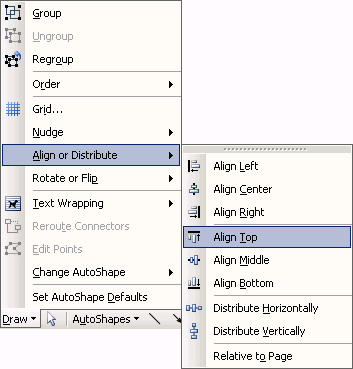
-
With all the pictures still selected, select Draw |
Align or Distribute | Distribute Horizontally. This will spread the
coffee cups out evenly across the page.

-
Repeat this process to insert more copies of the picture
and spread them around the bottom and sides, using Draw | Align or
Distribute | Distribute Vertically for the ones on the sides. Note that
when you are using Align Left and Align Right, Word will align
the pictures with the farthest left or right picture, so make sure that none
of the pictures overlaps the left or right page border.
-
When you have completed your borders, select all the
pictures at once and group them (Draw | Group). An easy way to select
all the pictures (instead of Shift+clicking on each one) is to click on the
Select Objects tool (to the right of the Draw menu) and use it to
draw a large rectangle (marquee) around all the objects.

-
Once you have grouped all the objects in your border, you
can save it as an AutoText entry. Press Alt+F3 and give your AutoText
entry a name, such as “Coffee Border.” Because your border has been saved in
the Header style, it will appear on the AutoText menu on the Header and
Footer toolbar.
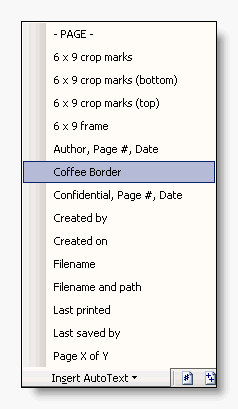
-
The final step is to remove the temporary page border you
used to help you align the pictures.
Inserting a clip art border can be accomplished in much the
same way in Word 2007, 2010, 2013, and 2016.
-
Begin by accessing the header; in Word 2007 and above you can do
this just by double-clicking in the header area. The contextual Header &
Footer Tools tab will be displayed.
-
Click Clip Art in the Insert group. This
will open the Clip Art task pane, from which you can insert the picture as
described above.
-
When you insert the picture, the contextual Picture
Tools | Format tab will be displayed (in recent versions, this has been
simplified to Picture Format), and all the controls you need to size the clip
art, change the wrapping, and position it are found on this Ribbon tab.
Note: Be aware that when you insert a large
picture in the header, even though Behind Text wrapping is selected, you
will not be able to return to the document body by double-clicking; you will
have to use the Close Header and Footer button on the Header &
Footer Tools tab.
Creating a border from an individual clip art picture is a
little more complicated. Because of changes in the graphics engine and drawing
tools, the Distribute command is not available for "pictures" (including
clip art) unless you use a drawing canvas, which adds an extra step.
-
First insert your page border outline: go to
Page Layout | Page Background | Page Borders and format the page border
as described in step 2 above.
-
Now you have to insert a drawing canvas in the header.
Double-click in the header area to access the header. Then select the
Insert tab and click on Shapes in the Illustrations group.
New Drawing Canvas is at the bottom of the Shapes gallery.
-
Stretch the canvas to the size of the temporary page
border and give it Behind Text wrapping.
-
You can then insert your clip art picture, duplicate it,
and use the Align and Distribute commands as described above.
-
After you've created and grouped your border, you can
display the Insert tab, click on Quick Parts in the Text
group, and choose Save Selection to Quick Part Gallery... to save it
as a building block (the equivalent of an AutoText entry).
Note: I am told that once you have completed the
border and grouped the pictures, you can drag the whole thing off the
drawing canvas and onto the page, then delete the drawing canvas. Good luck
with that! Also, as with the individual clip art, you will be unable to get
out of the header except by using the Close Header and Footer button;
double-clicking in the document body area doesn't work.
Another approach is available to you if you have Microsoft
Publisher installed:
-
Create a custom border in Publisher using your chosen
clip art picture. Although you don't have as much control over spacing, this
is a lot quicker!
-
Insert a text box of the desired size (this may take
some trial and error) and apply the custom border to it.
-
Then select the text box, right-click, and choose
Save as Picture. The selected object will be saved as a GIF file; the
default resolution is 96 dpi, suitable for Web use; you will want to click
Change... and change to 150 or 300 dpi. Give your picture a name such
as Coffee Border.
-
Once you have saved the border as a picture, you can
insert it in your header just as you would any other picture (click
Picture in the Insert group on the Header & Footer Tools
tab), then size and position it using the controls on the Picture Tools
tab.
This article copyright © 2004, 2008,
2011, 2014, 2023 by
Suzanne S. Barnhill.
|
